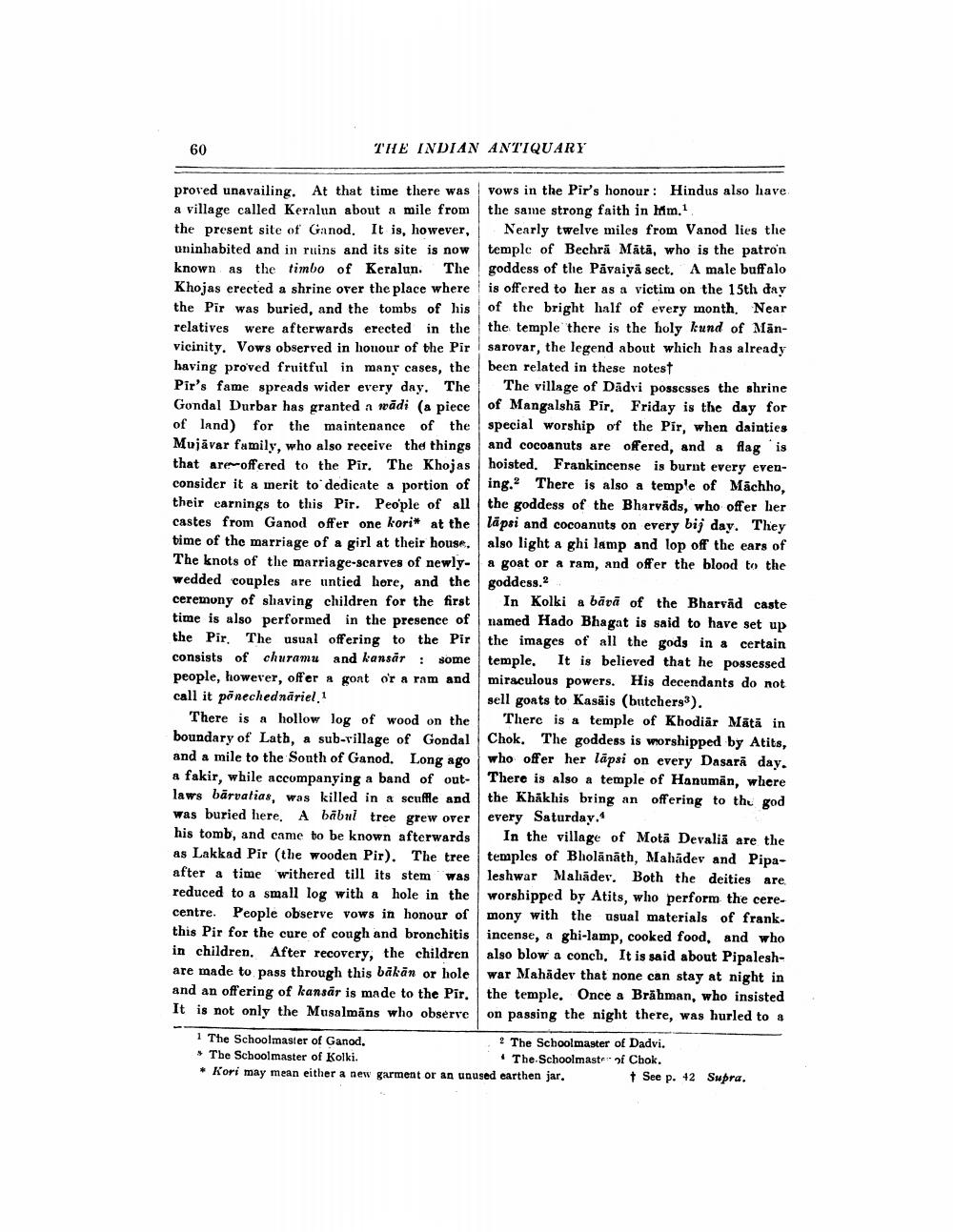________________
60
THE INDIAN ANTIQUARY
proved unavailing. At that time there was a village called Keralun about a mile from the present site of Ganod. It is, however, uninhabited and in ruins and its site is now known as the timbo of Keralun. The Khojas erected a shrine over the place where the Pir was buried, and the tombs of his relatives were afterwards erected in the vicinity. Vows observed in honour of the Pir having proved fruitful in many cases, the Pir's fame spreads wider every day. The Gondal Durbar has granted a wādi (a piece of land) for the maintenance of the Mujāvar family, who also receive the things that are offered to the Pir. The Khojas consider it a merit to dedicate a portion of their earnings to this Pir. People of all castes from Ganod offer one kori* at the time of the marriage of a girl at their house. The knots of the marriage-scarves of newlywedded couples are untied here, and the ceremony of shaving children for the first time is also performed in the presence of the Pir. The usual offering to the Pir consists of churamu and kansar some people, however, offer a goat or a ram and call it ponechednäriel.1
1 The Schoolmaster of Ganod. The Schoolmaster of Kolki.
There is a hollow log of wood on the boundary of Lath, a sub-village of Gondal and a mile to the South of Ganod. Long ago a fakir, while accompanying a band of outlaws bārvatias, was killed in a scuffle and was buried here. A babul tree grew over his tomb, and came to be known afterwards as Lakkad Pir (the wooden Pir). The tree after a time withered till its stem was reduced to a small log with a hole in the centre. People observe vows in honour of this Pir for the cure of cough and bronchitis in children. After recovery, the children are made to pass through this bäkän or hole and an offering of kansar is made to the Pir. It is not only the Musalmans who observe
vows in the Pir's honour: Hindus also have the same strong faith in him.1
Nearly twelve miles from Vanod lies the temple of Bechra Mata, who is the patron goddess of the Pavaiya sect. A male buffalo is offered to her as a victim on the 15th day of the bright half of every month. Near the temple there is the holy kund of Mansarovar, the legend about which has already been related in these notest
The village of Dädvi possesses the shrine of Mangalsha Pir. Friday is the day for special worship of the Pir, when dainties and cocoanuts are offered, and a flag is hoisted. Frankincense is burnt every evening. There is also a temple of Machho, the goddess of the Bharväds, who offer her lapsi and cocoanuts on every bij day. They also light a ghi lamp and lop off the ears of a goat or a ram, and offer the blood to the goddess.2
In Kolki a bava of the Bharvad caste named Hado Bhagat is said to have set up the images of all the gods in a certain temple. : It is believed that he possessed miraculous powers. His decendants do not sell goats to Kasais (butchers3).
There is a temple of Khodiär Mātā in Chok. The goddess is worshipped by Atits, who offer her lapsi on every Dasarā day. There is also a temple of Hanuman, where the Khakhis bring an offering to the god every Saturday.1
In the village of Mota Devalia are the temples of Bholanath, Mahadev and Pipaleshwar Mahadev. Both the deities are worshipped by Atits, who perform the ceremony with the usual materials of frankincense, a ghi-lamp, cooked food, and who also blow a conch. It is said about Pipaleshwar Mahadev that none can stay at night in the temple. Once a Brahman, who insisted on passing the night there, was hurled to a 2 The Schoolmaster of Dadvi. The Schoolmaster of Chok.
See p. 42 Supra.
* Kori may mean either a new garment or an unused earthen jar.




